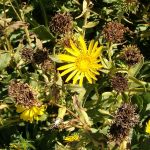| Common Name: |
Gumweed |
| Other Names: |
Rosinweed, tarweed, yerba del buey |
| Botanical Name: |
Grindelia camporum syn. G. robusta var. rigida |
| Genus: |
Grindelia |
| Family: |
Asteraceae |
| Native Location: |
California |
| Cultivation: |
Well-drained, poor soil in sun. |
| Propagation: |
By seed sown in spring at 16-19°C (61-66°F); by semi-ripe cuttings in summer. |
| Harvest: |
Plants are cut in full bloom and dried for use in infusions, liquid extracts, and tinctures, or used fresh in poultices. Flowers are preferred for tinctures. |
| Height: |
50cm-1.2m (20in-4ft) |
| Width: |
75cm (30in) |
| Hardiness: |
Z8 |
| Parts Used: |
Whole plant |
| Properties: |
A bitter, pungent, aromatic herb that is anti-inflammatory and expectorant, relaxes spasms, and has sedative effects. |
| Medicinal Uses: |
Internally for bronchitis, asthma, whooping cough, and cystitis. Externally for poison-ivy/oak rash, dermatitis, eczema and skin eruptions. Combined with Euphorbia hirta (See, asthma weed), Glycyrrhiza glabra (See, licorice), Inula helenium (See, Japanese Elecampane), Lobelia inflata (See, Chinese lobelia), or Primula veris (See, cowslip) for bronchial complaints. Excess may irritate the kidneys. |
| Culinary Uses: |
The gum is chewed like chewing gum. |
| Bibliography: |
Encyclopedia of Herbs by Deni Brown Copyright © 1995, 2001 Dorling Kindersley Limited Pg 228-229 |

